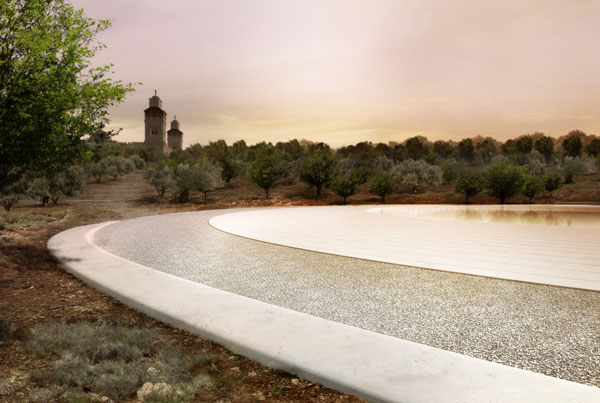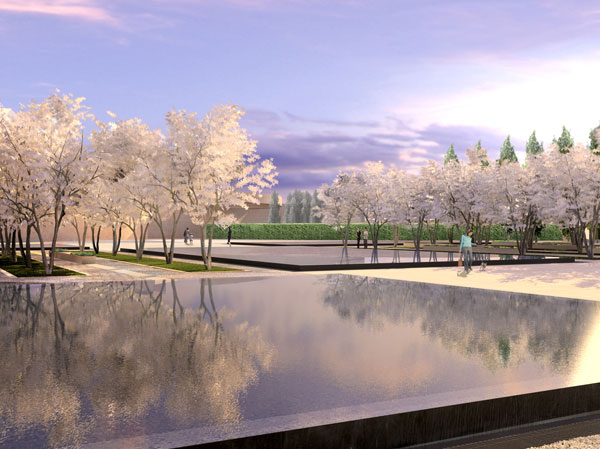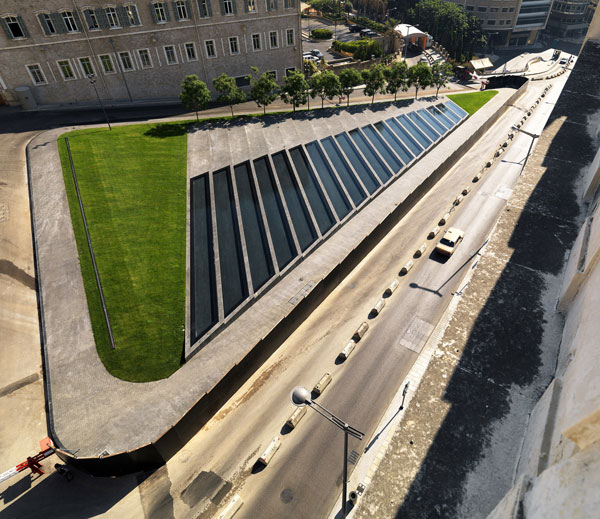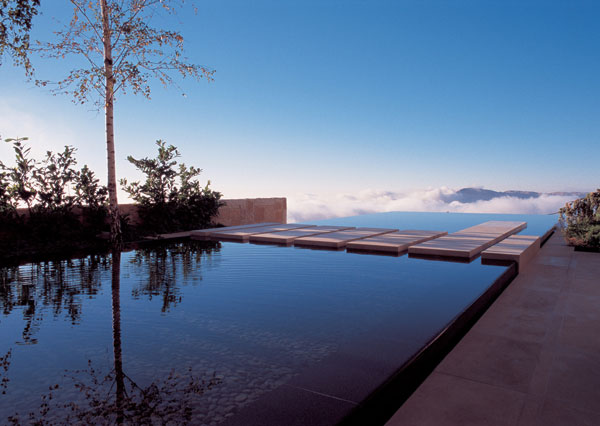News
Interview with Vladimir Djurovic, International ASLA
 Image credit: Joe Keserouani
Image credit: Joe Keserouani
You are well-known for creating innovative and poetic landscapes that put nature at center stage. What is your guiding design philosophy?
As you have already stated in your question, our guiding design philosophy is to put nature at center stage. We consider each project we take on as a unique opportunity to come up with environments that can somehow touch and affect people’s lives. We want to create places where people can reconnect with what is essential and natural. In this fast-paced era that we are living in nowadays, this need to reconnect is becoming increasingly crucial.
Our projects are scattered around the world, and we are always tackling different contexts, including sites, cultures, clients, and working with different architects, engineers, contractors, etc. Our projects try and capture the essence of all these parameters, while always striving to come up with holistic and serene places that can hopefully outlast us all.
The real challenge, however, is to reach a day where our needs become in tune with nature and we start building more conscientiously.
You recently won a few international design competitions for major cultural sites. The King Hussein Memorial in Amman, Jordan, is one. What stage of development is this project in? How do you plan to use landscape to commemorate the king?
We have just recently been notified that we have won this international competition. We are currently trying to resolve allocated budgets and time frames prior to proceeding with our design development.
When setting out to create the King Hussein Memorial Garden, we felt the need to evoke an atmosphere rather than impose a presence, withdrawing as designers to let the elements speak for themselves. The life of His Majesty the late King Hussein and the breadth of his achievements are inspirational, but most inspiring of all is the way he lived his life with the extraordinary humbleness of the truly great.
This strength and humbleness we have sought to evoke through a garden where every Jordanian finds his place. Contemplation gives way to awareness of the natural riches and beauty of the country, the value of its resources, and the legacy of its great leader, who remains eternally present. In this place, time is counted by the rhythm of flowing water and the seasons.
The primordial importance in the treatment of the landscape for the Memorial Garden was to create a haven of serenity, protected from the noise and pollution of the city. In a decisive gesture, we chose to carve out the land, creating moulded contours that gradually descend towards a focal point of contemplation. A dense plantation of oak trees on the outer perimeter of the garden works with the contours of the land to reinforce this natural buffer-zone.
As one penetrates down into the garden, the oak trees become interspersed with olive trees and almond trees and the ground clad in fragrant thyme. The garden is an environment generous in fruit and shade, deriving its natural beauty from its Jordanian geo-cultural specificity. The garden will provide for its own irrigation needs through a water-harvester beneath a sculpted circular pond. The almond trees, clustered around the pond, produce a dazzling array of white blossoms in the month of February, annually giving homage to the departure of King Hussein. Within weeks the blossoms fall, and petals are scattered poignantly on the surface of the water.
 Image credit: Vladmir Djurovic Landscape Architecture
Image credit: Vladmir Djurovic Landscape Architecture
The water marries closely the contours of the stone, creating a film of limpidity that draws in sun and moonlight, heightening the experience of the gently rippling surface. It also gives a message from the King to his people, a reminder of the scarcity of their most valuable resource. The ebb and flow of water are to be programmed to occur five times daily in harmony with the spiritual rhythms of daily life, just as the ebb and flow of the tides obey the rhythms of the moon.
 Image credit: Vladimir Djurovic Landscape Architecture
Image credit: Vladimir Djurovic Landscape Architecture
Another major project is the 10-hectare Aga Khan Museum + Ismaili Center in Toronto. The 10,000-square meter rectangular museum will revolve around a central courtyard. Your landscape will then bring together the museum with the new center. What guidance has The Aga Khan given you for the design of the landscape? How will you design the landscape to reflect Islamic art and culture?
His Highness The Aga Khan has been a major influence on me personally ever since he sent me on a world tour of historic places, from the Humayun Tombs and Fatipur Sikri in India, to ancient public spaces and mosques in Egypt, terminating with the truly timeless gardens at Al Hambra in Spain. The one thing that struck me following that is that projects we design should be planned for generations to come and not only to satisfy temporary programs and ambitions.
Our vision for the project is one that captures the essence of the Islamic garden and translates it into an expression that reflects its context and contemporary age. Embracing the five senses as the means to reach the soul, every space and garden are imbued with the delicate sensations that we seem to have lost in this fast-paced era. The ephemeral and the eternal are both essential to our composition of spaces. Shadows, light, petals, leaves and water in motion are complemented by the solidity and purity of created forms. All is not at once apparent; the garden reveals itself slowly to the visitor, who experiences hidden aspects with serendipity, a sort of search for the contemporary garden of paradise.
 Image credit: Vladimir Djurovic Landscape Architecture
Image credit: Vladimir Djurovic Landscape Architecture
You've done much of your work in Lebanon. After years of civil war and then the 2006 war with Israel, the country has focused on rebuilding its housing and infrastructure. Has there been equal investment in restoring its public spaces?
Unfortunately not. Public space initiatives have been almost non-existent since the entire 25-year civil war, and not only following the 2006 incident. The only savior in this respect has been a private company called Solidere, who have commissioned a few public areas which fall under their master plan of Beirut Central District. The rest of the country and its people are in dire need of such initiatives.
In Beirut, your Hariri Memorial Garden, a homage to the Lebanese prime minister who was assassinated in 2005, was designed to personify the values of Hariri. How did you turn Hariri's vision for Lebanon into landscape form?
Rafic Hariri will be remembered not only as a central figure in the country’s complex political scene, but also as the man who rebuilt Beirut’s war torn historic commercial centre by launching of the most ambitious construction program in the history of the country.
The project’s intent was to create a place that reflects the values of this historic figure, personified, pays tribute to his vision and achievements, and eternalizes his memory.
Elongated planes of gray stone and water mirrors, laid on a grass surface, step down towards the city. A row of jacaranda trees marks the edge between the steps and the Serail’s façade. The effect is solemn yet intimate, impressive yet simple, monumental yet humble. In essence, the design is a sober expression symbolizing the legacy of a visionary leader.
The project presents a limited palette of elements and materials, charged with symbolic significance. The steps symbolize the gradual rebuilding of Beirut and an open invitation to the city. The basalt stone planes symbolize grief, sobriety, and perseverance. The water mirrors symbolize life, purity, peace, and the immaterial. Grass symbolizes tenderness and compassion. The jacaranda trees symbolize joy, sorrow, hope, and through their cycle of birth and death, life’s constant renewal.
 Image credit: Matteo Piazza
Image credit: Matteo Piazza
Square Four, a park in Beirut's historic city center, keeps the focus on the site's beautiful old ficus trees. The design revolves around "framing and highlighting" these sculptural trees using a raised water mirror, and long wooden deck and benches. How did you come up with this approach? Do you always aim to preserve existing environments?
When existing environments have particular values and characters, we certainly aim to preserve and highlight them and try to capture the essence of that place and bring it forward for people to experience. Usually, just being in places like these and conducting very sensitive and thorough site analysis, we tend to get a lot of answers and cues from the place itself.
In the Basil Mountain Escape, a private residence in Lebanon, you wanted to create a sense of infinite space. Water, in this case, in a swimming pool, plays a major role. How did you accomplish this effect?
In minute and constricted spaces, in this case a 4.5-meter-set back around the house, we tried to incorporate every possible means to amplify the sense of space and its perception while providing all the needed living spaces. We started with the right section and hid all the undesirable views underneath while capturing all the desirable ones. We added a cantilevered water mirror that expands the space both physically and visually, framing and aligning all the various usable areas with the main focal points.
 Image credit: Geraldine Bruneel
Image credit: Geraldine Bruneel
The Basil Mountain Escape became a very good example of how restricted sites can still offer their users powerful experiences and interactions with nature.
Vladimir Djurovic, International ASLA, is principal of Vladimir Djurovic Landscape Architecture.
Interview conducted by Jared Green.